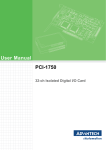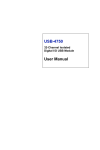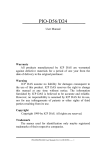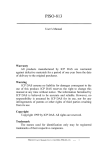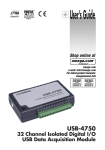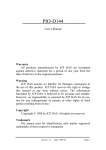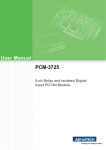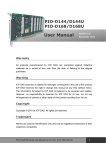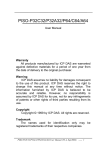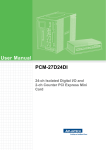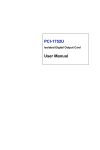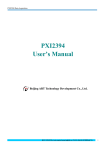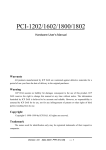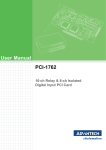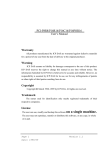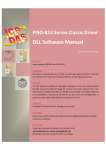Download PISO-730/730A
Transcript
PISO-730/730A
User’s Manual
Warranty
All products manufactured by ICP DAS are warranted
against defective materials for a period of one year from the
date of delivery to the original purchaser.
Warning
ICP DAS assumes no liability for damages consequent
to the use of this product. ICP DAS reserves the right to
change this manual at any time without notice. The
information furnished by ICP DAS is believed to be accurate
and reliable. However, no responsibility is assumed by ICP
DAS for its use, not for any infringements of patents or other
rights of third parties resulting from its use.
Copyright
Copyright 1999 by ICP DAS. All rights are reserved.
Trademark
The names used for identification only may be
registered trademarks of their respective companies.
PISO-730/730A User’s Manual (Ver.3.0, 9/9/2004) ----- 1
Tables of Contents
1.
2.
3.
4.
INTRODUCTION .....................................................................................................................3
1.1
FEATURES ...........................................................................................................................3
1.2
SPECIFICATIONS ..................................................................................................................4
1.3
ORDER DESCRIPTION ..........................................................................................................5
1.4
PCI DATA ACQUISITION FAMILY ...........................................................................................5
1.5
PRODUCT CHECK LIST .........................................................................................................6
HARDWARE CONFIGURATION............................................................................................7
2.1
BOARD LAYOUT ...................................................................................................................7
2.2
I/O OPERATION ...................................................................................................................8
2.3
INTERRUPT OPERATION .....................................................................................................13
2.4
DAUGHTER BOARDS ..........................................................................................................21
2.5
PIN ASSIGNMENT ...............................................................................................................25
I/O CONTROL REGISTER....................................................................................................27
3.1
HOW TO FIND THE I/O ADDRESS ........................................................................................27
3.2
THE ASSIGNMENT OF I/O ADDRESSES ................................................................................32
3.3
THE I/O ADDRESS MAP .....................................................................................................33
DEMO PROGRAM ................................................................................................................38
4.1
PIO_PISO........................................................................................................................39
4.2
DEMO1............................................................................................................................41
4.3
DEMO2............................................................................................................................43
4.4
DEMO3............................................................................................................................44
4.5
DEMO4............................................................................................................................46
4.6
DEMO5............................................................................................................................48
PISO-730/730A User’s Manual (Ver.3.0, 9/9/2004) ----- 2
1.
Introduction
The PISO-730 provides 32-channel isolated digital I/O (16×DI and 16×DO)
and 32-channel TTL-level digital I/O (16×DI and 16×DO). Each digital output offers a
NPN transistor and an integral suppression diode for inductive loads. The PISO-730A
provides 32-channel isolated digital I/O (16×DI and 16×DO) and 32-channel
TTL-level digital I/O (16×DI and 16×DO). Each digital output offers a PNP transistor and
an integral suppression diode for inductive loads. Both boards interface to field logic
signals, eliminate any ground-loop problems and isolate the host PC from
damaging voltages. The isolated I/O channels provide up to 3750Vdc of
protection.
The PISO-730/730A has one 37-pin D-type connector and two 20-pin flatcable connectors. The flat-cable can be connected to an ADP-20/PCI adapter.
The adapter can be fixed on the chassis, installs in a 5V PCI slot and can
support true Plug and Play”.
1.1
•
•
•
•
•
•
•
•
•
•
•
•
Features
PCI Bus
32 isolated DIO channels (16×DI and 16×DO)
32 TTL-level DIO channels (16×DI and 16×DO)
DC/DC converter build-in
One DB-37 D-type connector for isolated input and output
Two separate 20-pin connectors for non-isolated input and output
Up to 3750Vdc isolated voltage
Interrupt source: 2 channels
Connects directly to DB-24PR, 24POR, DB-24C, DB-16P, DB-16R
SMD, short card, power saving
Automatically detected by Windows 95/98/NT
No base address or IRQ switches to set
PISO-730/730A User’s Manual (Ver.3.0, 9/9/2004) ----- 3
1.2 Specifications
Isolated DIO channels
•
Optical isolated input channel
Channel Number: 16 digital inputs
Type: Isolated current input
Isolation voltage: 3750Vdc
Input voltage: 5-30Vdc
Input impedance: 1.2KΩ/1W
Response time: 10KHz (Max.)
•
Optical isolated output channel
Channel Number: 16 digital outputs
Output voltage: open-collector 10-30Vdc
Isolation voltage: 3750Vdc
Current Sinking (PISO-730): 100mA (Max.)
Current Sourcing (PISO-730A): 100mA(Max.)
Response time: 10KHz (Max.)
TTL-level DIO channels
•
•
TTL-level input channel
Channel Number: 16 digital inputs
Input voltage level: (TTL compatible)
VIL: 0.8V (Max.)
VIH: 2.4V (Min.)
TTL-level output channel
Channel Number: 16 digital outputs
Driver capacity: (TTL compatible)
IOL: 8 mA (sink)
IOH: 0.4 mA (source)
General specifications
• Operation Temp: 0-50°C
• Storage Temp: -20°C to 70°C
• Humidity: 0-90%, non-condensing
• Dimensions: 180mm×105mm
• Power consumption of PISO-730: 640mA
• Power consumption of PISO-730A: 600mA
PISO-730/730A User’s Manual (Ver.3.0, 9/9/2004) ----- 4
1.3 Order Description
•
PISO-730
16-channel isolated digital input & 16 channel isolated digital output (current
sinking) board
• PISO-730A:
16-channel isolated digital input & 16 channel isolated digital output (current
sourcing) board
1.3.1
•
•
•
•
•
•
•
•
Options
DB-24PR, DB-24PR: 24-channel power relay board
DB-24POR: 24-channel PhotoMos output board
DB-24C: 24-channel open-collector output board
DB-16P: 16-channel isolated D/I board
DB-16R: 16-channel relay board
ADP-20/PCI: Extender, 20-pin header to 20-pin header for PCI bus I/O
boards
DN-37: I/O connector block with DIN-Rail mounting and 37-pin D-type
connector
DB-37: 37-pin D-type connector pin-to-pin screw terminal for any 37-pin
D-type connector I/O board
1.4
PCI Data Acquisition Family
We provide a family of PCI-BUS data acquisition cards. These cards can
be divided into three groups as follows:
1. PCI-series: first generation, isolated or non-isolated cards
PCI-1002/1202/1800/1802/1602: multi-function family, non-isolated
PCI-P16R16/P16C16/P16POR16/P8R8: D/I/O family, isolated
PCI-TMC12: timer/counter card, non-isolated
2. PIO-series: cost-effective generation, non-isolated cards
PIO-823/821: multi-function family
PIO-D144/D96/D64/D56/D48/D24: D/I/O family
PIO-DA16/DA8/DA4: D/A family
3. PISO-series: cost-effective generation, isolated cards
PISO-813: A/D card
PISO-P32C32/P32A32/P64/C64/A64: D/I/O family
PISO-P8R8/P8SSR8AC/P8SSR8DC: D/I/O family
PISO-730/730A: D/I/O card
PISO-DA2: D/A card
PISO-730/730A User’s Manual (Ver.3.0, 9/9/2004) ----- 5
1.5
Product Check list
In addition to this manual, the package includes the following items:
• One PISO-730/PISO-730A card
• One company floppy diskette or CD
• One release note
1.
2.
3.
4.
Please read the release note first. All of the following important
information will be given in the release note:
The location of the software driver & utility
How to install software & utility
The location of the diagnostic program
FAQ
Attention!
If any of these items are missing or damaged, contact the dealer from
whom you purchased the product. Save all shipping materials and the carton in
case you want to ship or store the product in the future.
PISO-730/730A User’s Manual (Ver.3.0, 9/9/2004) ----- 6
2.
2.1
Hardware configuration
Board Layout
2.1.1
PISO-730/730A
CON1
PCI
controller
PCI BUS
2
7
8
JP1
1
Reserved
IN
20
2
19
CON2
1
19
CON3
20
1
OUT
2
CON1: 16-channel isolated D/I and 16-channel isolated D/O
CON2: 16-channel TTL-level (non-isolated) D/I
CON3: 16-channel TTL-level (non-isolated) D/O
JP1: Reserved
PISO-730/730A User’s Manual (Ver.3.0, 9/9/2004) ----- 7
2.2
I/O Operation
2.2.1
Non-isolated DO Port Architecture (CON3)
When the PC is powered-up, all operations of non-isolated DO states are
cleared to low state. The RESET\ signal is used to clear non-isolated DO states.
Refer to Sec. 3.3.1 for more information about the RESET\ signal.
•
The RESET\ is in Low-state
state
all non-isolated DO states are clear to low
Here’s block diagram of the non-isolated DO:
RESET\
clear
Data
input
CON3
Latch
Clock input
D/O buffer CKT
PISO-730/730A User’s Manual (Ver.3.0, 9/9/2004) ----- 8
2.2.2
Non-isolated DI Port Architecture (CON2)
When the PC is powered-up, non-isolated DI port operations are
disabled. The enable/disable for non-isolated DI ports is controlled by the
RESET\ signal. Refer to Sec. 3.3.1 for more information about the RESET\
signal.
•
•
The RESET\ is in Low-state
The RESET\ is in High-state
all non-isolated DI operation are disabled
all non-isolated DI operation are enabled
RESET\
Data
disable
Buffer
CON2
input
Clock input
D/I buffer CKT
PISO-730/730A User’s Manual (Ver.3.0, 9/9/2004) ----- 9
2.2.3
Isolated DO Port Architecture (CON1)
When the PC is powered-up, all operations of isolated DO states are cleared
to low state. The RESET\ signal is used to clear isolated DO states. Refer to
Sec. 3.3.1 for more information about RESET\ signal.
•
The RESET\ is in Low-state
all isolated DO states are clear to low state
Each eight open-collector output channel shares EO.COM (IDO0~IDO7 use
EO.COM1 and IDO8~IDO15 use EO.COM2)
The block diagram of isolated DO (current sinking) is as follows:
EO.COM1
IDO0
LOAD
IDO1
LOAD
IDO7
LOAD
External
Power supply
IGND
External
Internal of PISO-730
PISO-730/730A User’s Manual (Ver.3.0, 9/9/2004) ----- 10
The block diagram of isolated DO (current sourcing) is as follows:
EO.COM1
LOAD
IDO0
IGND
LOAD
IDO1
IGND
External
Power supply
LOAD
IDO7
IGND
External
Internal of PISO-730A
PISO-730/730A User’s Manual (Ver.3.0, 9/9/2004) ----- 11
2.2.4
Isolated DI Port Architecture (CON1)
The PISO-730/730A provides 16-channel isolated digital input. Each of the
isolated digital input can accept voltages from 3.5-30Vdc. Each eight input
channels share one external common end point. (IDI0~IDI7 use EI.COM1 and
IDI8~IDI15 use EI.COM2)
Vcc
IDI0
1.2K/1W
IDI1
1.2K/1W
IDI7
1.2K/1W
External power supply
3.5 - 30 Vdc
EI.COM1
External
PISO-730&PISO-730A
PISO-730/730A User’s Manual (Ver.3.0, 9/9/2004) ----- 12
2.3
Interrupt Operation
There are two interrupt sources in PISO-730/730A. These two signals are
named as INT_CHAN_0 and INT_CHAN_1. Their signal sources are given as
follows:
INT_CHAN_0: DI0
INT_CHAN_1: DI1
If only one interrupt signal source is used, the interrupt service routine does
not have to identify the interrupt source. Refer to DEMO3.C and DEMO4.C for
more information.
If there is more than one interrupt source, the interrupt service routine will
identify the active signals as follows: (refer to DEMO5.C)
1. Reads the new status of all interrupt signal sources (refer to Sec 3.3.5)
2. Compares the new status with the old status to identify the active signals
3. If INT_CHAN_0 is active, services it
4. If INT_CHAN_1 is active, services it
5. Updates interrupt status
Note: if the interrupt signal is too short, the new status may be as same as
old status. In that condition, the interrupt service routine can not identify
which interrupt source is active. So the interrupt signal must be
hold_active long enough until the interrupt service routine is executed.
This hold_time is different for different O.S. The hold_time can be as short
as a micro-second or as long as a second. In general, 20ms is enough for
any O. S.
PISO-730/730A User’s Manual (Ver.3.0, 9/9/2004) ----- 13
2.3.1 Interrupt Block Diagram of PISO-730/730A
INT_CHAN_0
INT_CHAN_1
INT\
0
Level_trigger
0
initial_low
active_high
The interrupt output signal of PISO-730/730A, INT\ is a level-trigger,
Active_Low signal. If the INT\ generates a low-pulse, the PISO-730 will
interrupt the PC once a time. If the INT\ is fixed in low level, the PISO-730 will
interrupt the PC continuously. So the INT_CHAN_0/1 must be controlled by
pulse_type signals. They must be fixed in low-level state normally
and generate a high_pulse to interrupt the PC.
The priority of INT_CHAN_0/1 is the same. If these two signals are active
at the same time, then INT\ will be activated only once. So the interrupt service
routine has to read the status of all interrupt channels for a multi-channel
interrupt. Refer to Sec. 2.6.7 for more information.
DEMO5.C
for multi-channel interrupt source
If only one interrupt source is used, the interrupt service routine doesn’t
have to read the status of interrupt source. The demo programs DEMO3.C and
DEMO4.C are designed for single-channel interrupt demo as follows:
DEMO3.C & DEMO4.C
for INT_CHAN_0 only
PISO-730/730A User’s Manual (Ver.3.0, 9/9/2004) ----- 14
2.3.2
INT_CHAN_0
INT_CHAN_0
DI0
Inverted/Noninverted select
INV0
Enable/Disable select
EN0
The INT_CHAN_0 must be fixed in a normal, low-level state
and generate a high_pulse to interrupt the PC.
The EN0 can be used to enable/disable the INT_CHAN_0 as follows:
(refer to Sec. 3.3.4)
EN0=0 INT_CHAN_0=disable
EN0=1 INT_CHAN_0=enable
The INV0 can be used to invert/non-invert the DI0 as follows: (Refer to
Sec. 3.3.6)
INV0=0 INT_CHAN_0=invert state of DI0
INV0=1 INT_CHAN_0=non-invert state of DI0
Refer to the following demo program for more information:
DEMO3.C
for INT_CHAN_0 (initial high)
DEMO4.C
for INT_CHAN_0 (initial low)
DEMO5.C
for multi-channel interrupt source
NOTE: Refer to Sec. 2.3.4 & Sec. 2.3.5 for active high-pulse
generation.
PISO-730/730A User’s Manual (Ver.3.0, 9/9/2004) ----- 15
2.3.3 INT_CHAN_1
INT_CHAN_1
DI1
Inverted/Noninverted select
INV1
Enable/Disable select
EN1
The INT_CHAN_1 must be fixed in a normal low-level state
and generated a high_pulse to interrupt the PC.
The EN1 can be used to enable/disable the INT_CHAN_1 as follows:
(refer to Sec. 3.3.4)
EN1=0 INT_CHAN_1=disable
EN1=1 INT_CHAN_1=enable
The INV1 can be used to invert/non-invert the DI1 as follows: (Refer to
Sec. 3.3.6)
INV1=0 INT_CHAN_1=invert state of DI1
INV1=1 INT_CHAN_1=non-invert state of DI1
Refer to demo program for more information as follows:
DEMO3.C
for INT_CHAN_0 (initial high)
DEMO4.C
for INT_CHAN_0 (initial low)
DEMO5.C
for multi-channel interrupt source
NOTE: Refer to Sec. 2.3.4 & Sec. 2.3.5 for active high-pulse
generation.
PISO-730/730A User’s Manual (Ver.3.0, 9/9/2004) ----- 16
2.3.4
Initial_high, active_low Interrupt source
If the DI0 is an initial_high, active_low signal, the interrupt service routine
should use INV0 to invert/non-invert the DI0 for high_pulse generation as
follows: (Refer to DEMO3.C and the DI1 is similarly)
Initial set:
now_int_state=1;
outportb(wBase+0x2a,0);
/* initial state for DI0
*/
/* select the inverted DI0 */
void interrupt irq_service()
{
if (now_int_state==1)
/* now DI0 is changed to LOW
*/(a)
{
/* --> INT_CHAN_0=!DI0=HIGH now
*/
COUNT_L++;
/* find a LOW_pulse (DI0)
*/
If((inport(wBase+7)&1)==0)/* the DI0 is still fixed in LOW */
{
/*
needs to generate a high_pulse */
outportb(wBase+0x2a,1);/* INV0 select the non-inverted input */(b)
/* INT_CHAN_0=DI0=LOW -->
*/
/* INT_CHAN_0 generate a high_pulse */
now_int_state=0;
/* now DI0=LOW
*/
}
else now_int_state=1; /* now DI0=HIGH
*/
/* doesn have to generate high_pulse */
}
else
/* now DI0 is changed to HIGH
*/(c)
{
/* --> INT_CHAN_0=DI0=HIGH now
*/
COUNT_H++;
/* find a HIGH_pulse (DI0)
*/
If((inport(wBase+7)&1)==1)/* the DI0 is still fixed in HIGH */
{
/* needs to generate a high_pulse
*/
outportb(wBase+0x2a,0);/* INV0 select the inverted input */(d)
/* INT_CHAN_0=!DI0=LOW -->
*/
/* INT_CHAN_0 generate a high_pulse */
now_int_state=1;
/* now DI0=HIGH
*/
}
else now_int_state=0; /* now DI0=LOW
*/
/* doesn have to generate high_pulse */
}
if (wIrq>=8) outportb(A2_8259,0x20);
outportb(A1_8259,0x20);
}
(a )
(b )
(c )
D I0
IN V 0
IN T _ C H A N _ 0
PISO-730/730A User’s Manual (Ver.3.0, 9/9/2004) ----- 17
(d )
2.3.5
Initial_low, active_high Interrupt source
If the DI0 is an initial_low, active_high signal, the interrupt service routine
should use INV0 to invert/non-invert the DI0 for high_pulse generation as
follows: (Refer to DEMO4.C and the DI1 is similarly)
Initial set:
now_int_state=0;
outportb(wBase+0x2a,1);
/* initial state for DI0
*/
/* select the non-inverted DI0 */
void interrupt irq_service()
{
if (now_int_state==1)
/* now DI0 is changed to LOW
*/(c)
{
/* --> INT_CHAN_0=!DI0=HIGH now
*/
COUNT_L++;
/* find a LOW_pulse (DI0)
*/
If((inport(wBase+7)&1)==0)/* the DI0 is still fixed in LOW */
{
/*
needs to generate a high_pulse */
outportb(wBase+0x2a,1);/* INV0 select the non-inverted input */(d)
/* INT_CHAN_0=DI0=LOW -->
*/
/* INT_CHAN_0 generate a high_pulse */
now_int_state=0;
/* now DI0=LOW
*/
}
else now_int_state=1; /* now DI0=HIGH
*/
/* doesn have to generate high_pulse */
}
else
/* now DI0 is changed to HIGH
*/(a)
{
/* --> INT_CHAN_0=DI0=HIGH now
*/
COUNT_H++;
/* find a High_pulse (DI0)
*/
If((inport(wBase+7)&1)==1)/* the DI0 is still fixed in HIGH */
{
/* needs to generate a high_pulse
*/
outportb(wBase+0x2a,0);/* INV0 select the inverted input */(b)
/* INT_CHAN_0=!DI0=LOW -->
*/
/* INT_CHAN_0 generate a high_pulse */
now_int_state=1;
/* now DI0=HIGH
*/
}
else now_int_state=0; /* now DI0=LOW
*/
/* doesn have to generate high_pulse */
}
if (wIrq>=8) outportb(A2_8259,0x20);
outportb(A1_8259,0x20);
}
(a )
(b )
(c )
D I0
IN V 0
IN T _ C H A N _ 0
PISO-730/730A User’s Manual (Ver.3.0, 9/9/2004) ----- 18
(d )
2.3.6
Multiple Interrupt Source
Assume: DI0 is initial Low, active High
DI1 is initial High, active Low
as follows:
DI0
DI1
DI0 & DI1 are
active at the
same time
DI0 & DI1 are
return to
normal at the
same time
DI1 is return
to normal
DI1 is active
Refer to DEMO5.C for source program. These three falling-edge & risingedge scenarios can be detected by DEMO5.C.
Note: When the interrupt is active, the user program has to identify the
active signals. More than one signal may be simultaneously. The interrupt
service routine has to service all active signals at the same time.
PISO-730/730A User’s Manual (Ver.3.0, 9/9/2004) ----- 19
Initial setting:
now_int_state=0x2;
/* Initial state: DI0 at low level, DI1 at high level */
invert=0x1;
/* non-invert DI0 & invert DI1
*/
outportb(wBase+0x2a,invert);
void interrupt irq_service(){
new_int_state=inportb(wBase+7)&0x03; /* read all interrupt state */
int_c=new_int_state^now_int_state; /* compare which interrupt */
/* signal has changed
*/
if ((int_c&0x1)!=0)
/* INT_CHAN_0 is active */
{
if ((new_int_state&0x01)!=0)
/* now DI0 changes to high */
{
CNT_H1++;
} else
/* now DI0 changes to low */
{
CNT_L1++;
} invert=invert^1;
/* to generate a high pulse */ }if ((int_c&0x2)!=0) { if
((new_int_state&0x02)!=0)
/* now DI1 change to high */
{
CNT_H2++;
} else
/* now DI1 changes to low */
{
CNT_L2++;
} invert=invert^2;
/* to generate a high pulse */ }
now_int_state=new_int_state;
outportb(wBase+0x2a,invert);
if (wIrq>=8) outportb(A2_8259,0x20);
outportb(A1_8259,0x20);
}
PISO-730/730A User’s Manual (Ver.3.0, 9/9/2004) ----- 20
2.4
Daughter Boards
2.4.1
DB-16P Isolated Input Board
The DB-16P is a 16-channel isolated digital input daughter board. The
optically isolated inputs of the DB-16P consist of a bi-directional photo-coupler
with a resistor that acts as a current senser. Use the DB-16P to sense DC
signals from TTL levels up to 24V or use the DB-16P to sense a wide range of
AC signals. This board can also isolate the computer from large common-mode
voltages, ground loops and transient voltage spikes that often occur in industrial
environments.
Va+
PISO-730/730A
VPhoto-Isolated
PISO-730/730A
20Pin cable
DB-16P
AC or DC Signal
0V to 24V
PISO-730/730A User’s Manual (Ver.3.0, 9/9/2004) ----- 21
2.4.2
DB-16R Relay Board
The DB-16R is a 16-channel relay output board, consisting of 16 form-C
relays for optimum program-controlled, load switching efficiency. The relays are
energized by applying a 12V/24V voltage signal to the appropriate relay channel
on the 20-pin flat connector. There are 16 enunciator LEDs for each relay, which
light when their associated relay is activated.
Form-C Relay
Normal Open
Normal Close
Com.
20Pin cable
DB-16R
PISO730/730A
Note:
Channel: 16 Form-C Relay
Relay: Switches up to 0.5A at 110ACV
or 1A at 24DCV
PISO-730/730A User’s Manual (Ver.3.0, 9/9/2004) ----- 22
2.4.3
DB-24PR, DB-24POR, DB-24C
DB-24PR
24*power relay, 5A/250V
DB-24POR
24*photoMOS relay, 0.1A/350VAC
DB-24C
24*open collector, 100mA per channel, 30V max.
The DB-24PR, is a 24-channel power relay output board. It consists of 8
form-C and 16 form-A electromechanical relays providing efficient programcontrolled load switching. Each relay contact can control a 5A load at
250ACV/30VDCV. The relay is energized by applying a 5-volt signal to the
appropriate relay channel on the 20-pin flat cable connector (only 16 are used)
or 50-pin flat cable connector (OPTO-22 compatible, for DIO-24 series). 24
enunciator LEDs, one for each relay, light when their associated relay is
activated. To avoid overloading your power supply, this board needs a +12VDC
or +24VDC external power supply.
Normal Open
Form A Relay
Com.
PISO-730/730A
DB-24PR
20-pin header
50-pin header
Note:
50-Pin connector (OPTO-22 compatible), for DIO-24, DIO-48, DIO-144,
PIO-D144, PIO-D96, PIO-D56, PIO-D48, PIO-D24
Channel: 16 Form-A Relays, 8 Form C Relays
Relay: Switches up to 5A at 110ACV / 5A at 30DCV
PISO-730/730A User’s Manual (Ver.3.0, 9/9/2004) ----- 23
2.4.4
Daughter Board Comparison Table
20-pin flat-cable
header
50-pin flat-cable
header
DB-37
header
DB-37
No
No
Yes
DN-37
No
No
Yes
ADP-37/PCI
No
Yes
Yes
ADP-50/PCI
No
Yes
No
DB-24P
No
Yes
No
DB-24PD
No
Yes
Yes
DB-16P8R
No
Yes
Yes
DB-24R
No
Yes
No
DB-24RD
No
Yes
Yes
DB-24C
Yes
Yes
Yes
DB-24PR
Yes
Yes
No
Db-24PRD
No
Yes
Yes
DB-24POR
Yes
Yes
Yes
DB-24SSR
No
Yes
Yes
NOTE: The PISO-730/730A has two 20-pin flat-cable headers, and one 37 pin
D-type Connector.
PISO-730/730A User’s Manual (Ver.3.0, 9/9/2004) ----- 24
2.5
Pin Assignment
2.5.1
Isolated I/O connector
CON1: The 37 pins of the D-type female connector
Pin No.
Description
Pin No
Description
1
IDI0
20
IDI1
2
IDI2
21
IDI3
3
IDI4
22
IDI5
4
IDI6
23
IDI7
5
IDI8
24
IDI9
6
IDI10
25
IDI11
7
IDI12
26
IDI13
8
IDI14
27
IDI15
9
EI.COM1
28
EI.COM2
10
EO.COM1
29
IGND
11
IDO0
30
IDO1
12
IDO2
31
IDO3
13
IDO4
32
IDO5
14
IDO6
33
IDO7
15
IDO8
34
IDO9
16
IDO10
35
IDO11
17
IDO12
36
IDO13
18
IDO14
37
IDO15
19
EO.COM2
2.5.2
JP1
Note: Reserved
2
4
6
8
1
3
5
7
JP1
PISO-730/730A User’s Manual (Ver.3.0, 9/9/2004) ----- 25
2.5.3
TTL-level I/O connector
CON2: The 20 pins of the flat-cable connector
Pin no.
Description
Pin no.
Description
1
DI0
2
DI1
3
DI2
4
DI3
5
DI4
6
DI5
7
DI6
8
DI7
9
DI8
10
DI9
11
DI10
12
DI11
13
DI12
14
DI13
15
DI14
16
DI15
17
D.GND
18
D.GND
19
+5V
20
+12V
CON3: The 20 pins of the flat-cable connector
Pin no.
Description
Pin no.
Description
1
DO0
2
DO1
3
DO2
4
DO3
5
DO4
6
DO5
7
DO6
8
DO7
9
DO8
10
DO9
11
DO10
12
DO11
13
DO12
14
DO13
15
DO14
16
DO15
17
D.GND
18
D.GND
19
+5V
20
+12V
All signals are TTL compatible
PISO-730/730A User’s Manual (Ver.3.0, 9/9/2004) ----- 26
3.
I/O Control Register
3.1
How to Find the I/O Address
The plug & play BIOS will assign a proper I/O address to every PIO/PISO
series card during the power-up stage. The fixed IDs of PIO/PISO series cards
are given as follows:
PISO-730
<Rev1.0~Rev2.0>
Vender ID=
Device ID=
Sub-Vendor ID=
Sub-Device ID=
Sub-Aux ID=
0xE159
0x02
0x80
0x08
0x40
PISO-730
<Rev3.0>
PISO-730A
<Rev3.0>
Vender ID=
Device ID=
Sub-Vendor ID=
Sub-Device ID=
Sub-Aux ID=
0xE159
0x02
0x80
0x08
0x80
PISO-730A
<Rev4.0>
Vender ID=
Device ID=
Sub-Vendor ID=
Sub-Device ID=
Sub-Aux ID=
0xE159
0x01
0xc2ff
0x00
0x40
Vender ID=
Device ID=
Sub-Vendor ID=
Sub-Device ID=
Sub-Aux ID=
PISO-730/730A User’s Manual (Ver.3.0, 9/9/2004) ----- 27
0xE159
0x01
0x62ff
0x00
0x80
We provide the following all necessary functions as follows:
1. PIO_DriverInit(&wBoard, wSubVendor, wSubDevice, wSubAux)
2. PIO_GetConfigAddressSpace(wBoardNo,*wBase,*wIrq, *wSubVendor,
*wSubDevice, *wSubAux, *wSlotBus, *wSlotDevice)
3. Show_PIO_PISO(wSubVendor, wSubDevice, wSubAux)
All functions are defined in PIO.H. Refer to Chapter 4 for more information. Here
important driver information:
1. Resource-allocated information:
• wBase : BASE address mapping in this PC
• wIrq: IRQ channel number allocated in this PC
2. PIO/PISO identification information:
• wSubVendor: subVendor ID of this board
• wSubDevice: subDevice ID of this board
• wSubAux: subAux ID of this board
3. PC physical slot information:
• wSlotBus: hardware slot ID1 in this PC slot position
• wSlotDevice: hardware slot ID2 in this PC slot position
The utility program,
PIO_PISO.EXE, detects & shows all PIO/PISO cards
installed in this PC. Refer to Sec. 4.1 for more information.
PISO-730/730A User’s Manual (Ver.3.0, 9/9/2004) ----- 28
3.1.1
PIO_DriverInit
PIO_DriverInit(&wBoards, wSubVendor,wSubDevice,wSubAux)
• wBoards=0 to N
number of boards found in this PC
• wSubVendor
subVendor ID of board to find
• wSubDevice
subDevice ID of board to find
• wSubAux
subAux ID of board to find
This function detects all PIO/PISO series card in the system. Implemented
is based on the PCI plug & play mechanism-1. It will find all installed PIO/PISO
series cards in this system, and saves all their resource in the library.
Sample program 1: Finds all PISO-730/730A in this PC
wSubVendor=0x80; wSubDevice=8; wSubAux=0x40; /* for PISO-730 */
; wSubAux=0x80; /* for PISO-730A*/
wRetVal=PIO_DriverInit(&wBoards, wSubVendor,wSubDevice,wSubAux);
printf("There are %d PISO-730 Cards in this PC\n",wBoards);
/* step2: Save resource of all PISO-730/730A cards installed in this PC */
for (i=0; i<wBoards; i++)
{ PIO_GetConfigAddressSpace(i,&wBase,&wIrq,&wID1,&wID2,&wID3,
&wID4,&wID5);
printf("\nCard_%d: wBase=%x, wIrq=%x", i,wBase,wIrq);
wConfigSpace[i][0]=wBaseAddress;
/*save all resource of this card */
wConfigSpace[i][1]=wIrq;
/* save all resource of this card */
}
Sample program 2: Find all PIO/PISO in this PC (Refer to Sec. 4.1 for more
information)
wRetVal=PIO_DriverInit(&wBoards,0xff,0xff,0xff); /*find all PIO_PISO*/
printf("\nThere are %d PIO_PISO Cards in this PC",wBoards);
if (wBoards==0 ) exit(0);
printf("\n-----------------------------------------------------");
for(i=0; i<wBoards; i++)
{
PIO_GetConfigAddressSpace(i,&wBase,&wIrq,&wSubVendor,
&wSubDevice,&wSubAux,&wSlotBus,&wSlotDevice);
printf("\nCard_%d:wBase=%x,wIrq=%x,subID=[%x,%x,%x],
SlotID=[%x,%x]",i,wBase,wIrq,wSubVendor,wSubDevice,
wSubAux,wSlotBus,wSlotDevice);
printf(" --> ");
ShowPioPiso(wSubVendor,wSubDevice,wSubAux);
}
PISO-730/730A User’s Manual (Ver.3.0, 9/9/2004) ----- 29
3.1.2
PIO_GetConfigAddressSpace
PIO_GetConfigAddressSpace(wBoardNo,*wBase,*wIrq, *wSubVendor,
*wSubDevice, *wSubAux, *wSlotBus, *wSlotDevice)
• wBoardNo=0 to N
total number of N+1 boards found by
PIO_DriveInit(….)
• wBase
base address of the board control word
• wIrq
allocates IRQ channel number of this board
• wSubVendor
subVendor ID of this board
• wSubDevice
subDevice ID of this board
• wSubAux
subAux ID of this board
• wSlotBus
hardware slot ID1 of this board
• wSlotDevice
hardware slot ID2 of this board
Use this function to save the resources of all PIO/PISO cards installed in
this system. Afterward, the application program can directly control all functions
of PIO/PISO series card.
Find the configure address space of PISO-730/730A:
/* step1: detect all PISO-730/730A cards first */
wSubVendor=0x80; wSubDevice=8; wSubAux=0x40; /* for PISO-730 */
;wSubAux=0x80; /* for PISO-730A */
wRetVal=PIO_DriverInit(&wBoards, wSubVendor,wSubDevice,wSubAux);
printf("There are %d PISO-730 Cards in this PC\n",wBoards);
/* step2: save resource of all PISO-730/730A cards installed in this PC */
for (i=0; i<wBoards; i++)
{ PIO_GetConfigAddressSpace(i,&wBase,&wIrq,&t1,&t2,&t3,&t4,&t5);
printf("\nCard_%d: wBase=%x, wIrq=%x", i,wBase,wIrq);
wConfigSpace[i][0]=wBaseAddress; /* save all resource of this card
*/
wConfigSpace[i][1]=wIrq;
/* save all resource of this card
*/
}
/* step3: control the PISO-730/730A directly */
wBase=wConfigSpace[0][0];
/* get base address the card_0
*/
outport(wBase,1);
/* enable all D/I/O operation of card_0 * /
wBase=wConfigSpace[1][0];
/* get base address the card_1
*/
outport(wBase,1);
/* enable all D/I/O operation of card_1
*/
PISO-730/730A User’s Manual (Ver.3.0, 9/9/2004) ----- 30
3.1.3
Show_PIO_PISO
Show_PIO_PISO(wSubVendor,wSubDevice,wSubAux)
• wSubVendor
subVendor ID of board to find
• wSubDevice
subDevice ID of board to find
• wSubAux
subAux ID of board to find
This function shows a text string for these special subIDs. This text string is the
same as that defined in PIO.H
Here the demo program for this function:
wRetVal=PIO_DriverInit(&wBoards,0xff,0xff,0xff); /*find all PIO_PISO*/
printf("\nThrer are %d PIO_PISO Cards in this PC",wBoards);
if (wBoards==0 ) exit(0);
printf("\n-----------------------------------------------------");
for(i=0; i<wBoards; i++)
{
PIO_GetConfigAddressSpace(i,&wBase,&wIrq,&wSubVendor,
&wSubDevice,&wSubAux,&wSlotBus,&wSlotDevice);
printf("\nCard_%d:wBase=%x,wIrq=%x,subID=[%x,%x,%x],
SlotID=[%x,%x]",i,wBase,wIrq,wSubVendor,wSubDevice,
wSubAux,wSlotBus,wSlotDevice);
printf(" --> ");
ShowPioPiso(wSubVendor,wSubDevice,wSubAux);
}
PISO-730/730A User’s Manual (Ver.3.0, 9/9/2004) ----- 31
3.2 The Assignment of I/O Address
The plug & play BIOS assigns the proper I/O address to each PIO/PISO
series card. If there is only one PIO/PISO board, the board is identified as
card_0. If there are two PIO/PISO boards in the system, identifying card_0
becomes more difficult? The software driver can support a maximum of 16
boards. Therefore, you can install up to 16 boards of PIO/PSIO series in one
PC system. Here how to identify each address.
The easiest way to identify which card is card_0 is to use wSlotBus &
wSlotDevice as follows:
1. Remove all PISO-730/730A from this PC
2. Install one PISO-730/730A into the PC PCI_slot1, run PIO_PISO.EXE &
record the wSlotBus1 & wSlotDevice1
3. Remove all PISO-730/730A from this PC
4. Install one PISO-730/730A into the PC PCI_slot2, run PIO_PISO.EXE &
record the wSlotBus2 & wSlotDevice2
5. Repeat (3) & (4) for all PCI_slot? Record all wSlotBus? & wSlotDevice?
The records may be as follows:
PC PCI slot
WSlotBus
wSlotDevice
Slot_1
0
0x07
Slot_2
0
0x08
Slot_3
0
0x09
Slot_4
0
0x0A
Slot_5
1
0x0A
Slot_6
1
0x08
Slot_7
1
0x09
Slot_8
1
0x07
PCI-BRIDGE
The above procedure will record all wSlotBus? & wSlotDevice? in this PC.
These values will be mapped to this PC physical slot. This mapping will not be
changed for any PIO/PISO cards. Use it to identify the specified PIO/PISO card
as follows:
Step1: Record all wSlotBus? & wSlotDevice?
Step2: Use PIO_GetConfigAddressSpace(…) to get the specified card wSlotBus & wSlotDevice
Step3: Identify the specified PIO/PISO card by comparing the wSlotBus &
wSlotDevice in step2 to step1.
PISO-730/730A User’s Manual (Ver.3.0, 9/9/2004) ----- 32
3.3
The I/O Address Map
A PIO / PISO series card address is automatically assigned by the
main board ROM BIOS. The I/O address can also be re-assigned if
needed, It is strongly recommended not to change the I/O address.
The plug&play BIOS assigns the proper I/O address for each
PIO/PISO series card. Here are the of PISO-730/730A I/O addresses:
Address
Read
Write
WBase+0
RESET\ control register
Same
WBase+2
Aux control register
Same
WBase+3
Aux data register
Same
WBase+5
INT mask control register
Same
WBase+7
Aux pin status register
Same
WBase+0x2 INT polarity control register Same
a
WBase+0xc IDI0∼IDI7
0
IDO0∼IDO7
WBase+0xc IDI8∼IDI15
4
IDO8∼IDO15
WBase+0xc DI0∼DI7
8
DO0∼DO7
Wbase+0xcc DI8∼DI15
DO8∼DO15
Note. Refer to Sec. 3.1 for more information about wBase.
PISO-730/730A User’s Manual (Ver.3.0, 9/9/2004) ----- 33
3.3.1
RESET\ Control Register
(Read/Write): wBase+0
Bit 7
Bit 6
Bit 5
Bit 4
Bit 3
Bit 2
Bit 1
Bit 0
Reserved Reserved Reserved Reserved Reserved Reserved Reserved RESET\
Note. Refer to Sec. 3.1 for more information about wBase.
When the PC is first powered-up, the RESET\ signal is in Low state. This
disables all D/I/O operations. Please set the RESET\ signal to High state
before issuing any D/I/O command.
outportb(wBase,1);
/* RESET\ = High
all D/I/O are enable now */
outportb(wBase,0);
/* RESET\ = Low
all D/I/O are disable now */
3.3.2
AUX Control Register
(Read/Write): wBase+2
Bit 7
Bit 6
Bit 5
Bit 4
Bit 3
Bit 2
Bit 1
Bit 0
Aux7
Aux6
Aux5
Aux4
Aux3
Aux2
Aux1
Aux0
Note. Refer to Sec. 3.1 for more information about wBase.
Aux?=0 this Aux is used as a D/I
Aux?=1 this Aux is used as a D/O
When the PC is first powered-on, all Aux? signal are in Low-state. all Aux?
are designed as D/I for all PIO/PISO series. Please set all Aux? in D/I state.
3.3.3
AUX data Register
(Read/Write): wBase+3
Bit 7
Bit 6
Bit 5
Bit 4
Bit 3
Bit 2
Bit 1
Bit 0
Aux7
Aux6
Aux5
Aux4
Aux3
Aux2
Aux1
Aux0
Note. Refer to Sec. 3.1 for more information about wBase.
When the Aux? is used as a D/O, this register controls the output state.
This register has been designed for future extensions, so please don try to
control this register now.
PISO-730/730A User’s Manual (Ver.3.0, 9/9/2004) ----- 34
3.3.4
INT Mask Control Register
(Read/Write): wBase+5
Bit 7
Bit 6
Bit 5
Bit 4
Bit 3
Bit 2
Bit 1
Bit 0
0
0
0
0
0
0
EN1
EN0
Note. Refer to Sec. 3.1 for more information about wBase.
EN0/1=0
EN0/1=1
Disables INT_CHAN_0/1 as a interrupt signal (default)
Enables INT_CHAN_0/1 as a interrupt signal
outportb(wBase+5,0);
/* Disables all interrupts
outportb(wBase+5,1);
outportb(wBase+5,2);
outportb(wBase+5,3);
/* Enables interrupt of INT_CHAN_0 */
/* Enables interrupt of INT_CHAN_1 */
/* Enables all two channels of interrupt */
Refer to the following demo program for more information:
DEMO3.C
For INT_CHAN_0 only (initial high state)
DEMO4.C
For INT_CHAN_0 only (initial low state)
DEMO5.C
For multi-channel interrupt sources
PISO-730/730A User’s Manual (Ver.3.0, 9/9/2004) ----- 35
*/
3.3.5
Aux Status Register
(Read/Write): wBase+7
Bit 7
Bit 6
Bit 5
Bit 4
Bit 3
Bit 2
Bit 1
Bit 0
Aux7
Aux6
Aux5
Aux4
Aux3
Aux2
Aux1
Aux0
Note. Refer to Sec. 3.1 for more information about wBase.
Aux0=INT_CHAN_0, Aux1=INT_CHAN_1, Aux7~4=Aux-ID. Refer to Sec.
4.1 for more information. The Aux0~1 are used as interrupt sources. The
interrupt service routine has to read this register for interrupt source
identification. Refer to Sec. 2.5 for more information.
3.3.6
Interrupt Polarity Control Register
(Read/Write): wBase+0x2A
Bit 7
Bit 6
Bit 5
Bit 4
Bit 3
Bit 2
Bit 1
Bit 0
0
0
0
0
0
0
INV1
INV0
Note. Refer to Sec. 3.1 for more information about wBase.
INV0/1=0 Selects the inverted signal from INT_CHAN_0/1
INV0/1=1 Selects the non-inverted signal from INT_CHAN_0/1
outportb(wBase+0x2a,0); /* Selects the invert input from all 2 channels
*/
outportb(wBase+0x2a,0x3);/* Selects the non-invert input from all 2 channels */
outportb(wBase+0x2a,0x2);/* Selects the inverted input of INT_CHAN_0
*/
/* Selects the non-inverted input of INT_CHAN_1 */
Refer to Sec. 2.6.7 for more information.
Refer to DEMO5.C for more information.
PISO-730/730A User’s Manual (Ver.3.0, 9/9/2004) ----- 36
3.3.7
I/O Data Register
(Read/Write): wBase+0xC0
Bit 7
Bit 6
Bit 5
Bit 4
Bit 3
Bit 2
Bit 1
Bit 0
IDI7
IDI6
IDI5
IDI4
IDI3
IDI2
IDI1
IDI0
(Read/Write): wBase+0xC4
Bit 7
Bit 6
Bit 5
Bit 4
Bit 3
Bit 2
Bit 1
Bit 0
IDI15
IDI14
IDI13
IDI12
IDI11
IDI10
IDI9
IDI8
(Read/Write): wBase+0xC8
Bit 7
Bit 6
Bit 5
Bit 4
Bit 3
Bit 2
Bit 1
Bit 0
DI7
DI6
DI5
DI4
DI3
DI2
DI1
DI0
(Read/Write): wBase+0xCC
Bit 7
Bit 6
Bit 5
Bit 4
Bit 3
Bit 2
Bit 1
Bit 0
DI15
DI14
DI13
DI12
DI11
DI10
DI9
DI8
Note. Refer to Sec. 3.1 for more information about wBase.
outportb(wBase+0xc0,0xff);
DiValue=inportb(wBase+0xc0);
/* Writes 0xff to IDO0~IDO7
/* Reads states from IDI0~IDI7
*/
*/
outportb(wBase+0xc8,0x55);
DiValue=inportb(wBase+0xcc);
/* Writes 0x55 to DO0~DO7
/* Reads states from DI8~DI15
*/
*/
PISO-730/730A User’s Manual (Ver.3.0, 9/9/2004) ----- 37
4.
Demo Program
It is recommended to read the release note first. All of the following
important information will be given in release note:
1. The location of the software driver & utility
2. Installing the software & utility
3. The location of the diagnostic program
4. FAQ
There are many demo programs given in the company floppy disk or CD.
After the software installation, the driver will be installed as follows:
•
•
•
\TC\*.*
\MSC\*.*
\BC\*.*
for Turbo C 2.xx or above
for MSC 5.xx or above
for BC 3.xx or above
•
•
•
\TC\LIB\*.*
\TC\DEMO\*.*
\TC\DIAG\*.*
for TC library
for TC demo program
for TC diagnostic program
•
•
•
•
•
•
\TC\LIB\Large\*.*
\TC\LIB\Huge\*.*
\TC\LIB\Large\PIO.H
\TC\\LIB\Large\TCPIO_L.LIB
\TC\LIB\Huge\PIO.H
\TC\\LIB\Huge\TCPIO_H.LIB
TC large model library
TC huge model library
TC declaration file
TC large model library file
TC declaration file
TC huge model library file
•
•
•
•
\MSC\LIB\Large\PIO.H
\MSC\LIB\Large\MSCPIO_L.LIB
\MSC\LIB\Huge\PIO.H
\MSC\\LIB\Huge\MSCPIO_H.LIB
MSC declaration file
MSC large model library file
MSC declaration file
MSC huge model library file
•
•
•
•
\BC\LIB\Large\PIO.H
\BC\LIB\Large\BCPIO_L.LIB
\BC\LIB\Huge\PIO.H
\BC\\LIB\Huge\BCPIO_H.LIB
BC declaration file
BC large model library file
BC declaration file
BC huge model library file
NOTE: The library is available for all PIO/PISO series cards.
PISO-730/730A User’s Manual (Ver.3.0, 9/9/2004) ----- 38
4.1
PIO_PISO
/* ------------------------------------------------------------------------*/
/* Find all PIO_PISO series cards in this PC system
*/
/* step 1 : plug all PIO_PISO cards into PC
*/
/* step 2 : run PIO_PISO.EXE
*/
/* -----------------------------------------------------------------------*/
#include "PIO.H"
WORD wBase,wIrq;
WORD wBase2,wIrq2;
int main()
{
int i,j,j1,j2,j3,j4,k,jj,dd,j11,j22,j33,j44;
WORD wBoards,wRetVal;
WORD wSubVendor,wSubDevice,wSubAux,wSlotBus,wSlotDevice;
char c;
float ok,err;
clrscr();
wRetVal=PIO_DriverInit(&wBoards,0xff,0xff,0xff); /*for PIO-PISO*/
printf("\nThere are %d PIO_PISO Cards in this PC",wBoards);
if (wBoards==0 ) exit(0);
printf("\n-----------------------------------------------------");
for(i=0; i<wBoards; i++)
{
PIO_GetConfigAddressSpace(i,&wBase,&wIrq,&wSubVendor,
&wSubDevice,&wSubAux,&wSlotBus,&wSlotDevice);
printf("\nCard_%d:wBase=%x,wIrq=%x,subID=[%x,%x,%x],
SlotID=[%x,%x]",i,wBase,wIrq,wSubVendor,wSubDevice,
wSubAux,wSlotBus,wSlotDevice);
printf(" --> ");
ShowPioPiso(wSubVendor,wSubDevice,wSubAux);
}
PIO_DriverClose();
}
NOTE: the PIO_PISO.EXE is valid for all PIO/PISO cards. It is located in
\TC\DIAG\ directory. Execute the PIO_PISO.EXE to get the following
information:
• A list all PIO/PISO cards installed in this PC
• A list all resources allocated to every PIO/PISO cards
• A list the wSlotBus & wSlotDevice for specified PIO/PISO card identification.
(Refer to Sec. 3.2 for more information)
PISO-730/730A User’s Manual (Ver.3.0, 9/9/2004) ----- 39
4.1.1
PIO_PISO.EXE for Windows
PIO_PISO.EXE is a software utility for Windows95/98. For detailed
information about this file, please refer to the readme.txt” of your Windows 95/98
development toolkit. It is useful for all PIO/PISO series cards.
Here are the setup steps from the CD-ROM:
• Step1: Toolkit(Software)/Manuals
• Step2: I Agree
• Step3: PCI Bus DAQ Card
• Step4: PIO_PISO
• Step5: Installs Toolkits for Windows95/98
• Step6: After installation, this program will be extracted in user define
directory.
After executing the utility, all detailed information for all PIO/PISO cards
installed in the PC will be shown as follows:
PISO-730/730A User’s Manual (Ver.3.0, 9/9/2004) ----- 40
4.2
DEMO1
/* DEMO1.C : PISO-730/730A D/O demo
*/
/* step 1 : connect CON3 to DB-16R
*/
/* step 2 : run DEMO1.EXE
*/
/* -------------------------------------------------------------- */
#include "PIO.H"
void piso_730_do(long lDoValue);
void piso_730_ido(long lDoValue);
WORD wBase,wIrq;
int main()
{
int i,j,k1,k2,l1,l2,jj,dd,j1,i1,j2,i2;
WORD wBoards,wRetVal,t1,t2,t3,t4,t5;
WORD wSubVendor,wSubDevice,wSubAux,wSlotBus,wSlotDevice;
long lOutPad1,lOutPad2;
char c;
clrscr();
/* step 1: find address-mapping of PIO/PISO cards
*/
wRetVal=PIO_DriverInit(&wBoards,0x80,0x08,0x40); /* for PISO-730 */
,0x80); /* for PISO-730A*/
printf("\nThere are %d PISO-730/730A Cards in this PC",wBoards);
if (wBoards==0) exit(0);
printf("\n--------------- The Configuration Space ---------------");
for(i=0; i<wBoards; i++)
{
PIO_GetConfigAddressSpace(i,&wBase,&wIrq,&wSubVendor,&wSubDevice,
&wSubAux,&wSlotBus,&wSlotDevice);
printf("\nCard_%d: wBase=%x,wIrq=%x,subID=[%x,%x,%x],SlotID=
[%x,%x]",i,wBase,wIrq,wSubVendor,wSubDevice,wSubAux,
wSlotBus,wSlotDevice);
printf(" --> ");
ShowPioPiso(wSubVendor,wSubDevice,wSubAux);
}
PIO_GetConfigAddressSpace(0,&wBase,&wIrq,&t1,&t2,&t3,&t4,&t5);
/* step 2: enable all D/I/O port
*/
outportb(wBase,1);
/* enable D/I/O */
printf("\n\n");
lOutPad1=1;
lOutPad2=0x8000;
for(;;)
{
gotoxy(1,6);
piso_730_do(lOutPad1);
printf("\nOutput DO[0..15] = [%4lx]",lOutPad1);
piso_730_ido(lOutPad2);
printf("\nOutput IDO[0..15] = [%4lx]",lOutPad2);
delay(12000);
lOutPad1=((lOutPad1<<1)&0xffff);
lOutPad2=((lOutPad2>>1)&0xffff);
if (lOutPad1==0) {lOutPad1=1;lOutPad2=0x8000;}
if (kbhit()!=0) break;
}
PIO_DriverClose();
PISO-730/730A User’s Manual (Ver.3.0, 9/9/2004) ----- 41
}
/* -------------------------------------------------------------- */
void piso_730_do(long lDoValue)
{
outportb(wBase+0xc8,(lDoValue&0xff));
outportb(wBase+0xcc,((lDoValue>>8)&0xff));
}
/* -------------------------------------------------------------- */
void piso_730_ido(long lDoValue)
{
outportb(wBase+0xc0,(lDoValue&0xff));
outportb(wBase+0xc4,((lDoValue>>8)&0xff));
}
PISO-730/730A User’s Manual (Ver.3.0, 9/9/2004) ----- 42
4.3
DEMO2
/* DEMO2.C : PISO-730/730A D/I/O demo
*/
/* step 1 : connect DO[0..15] to DI[0..15],
*/
/*
IDO[0..15] to IDI[0..15]
*/
/* step 2 : run DEMO2.EXE
*/
/* ------------------------------------------------------------- */
#include "PIO.H"
long piso_730_di(void);
long piso_730_idi(void);
WORD wBase,wIrq;
int main()
{
int i,j,k,k1,k2,l1,l2,jj,dd,j1,i1,j2,i2;
WORD wBoards,wRetVal,t1,t2,t3,t4,t5;
WORD wSubVendor,wSubDevice,wSubAux,wSlotBus,wSlotDevice;
long lOutPad1,lOutPad2,lInPad1,lInPad2;
char c;
clrscr();
/* step 1: find address-mapping of PIO/PISO cards
*/
.
.
/* step 2: enable all D/I/O port
*/
outportb(wBase,1);
/* enable D/I/O */
lOutPad1=0x0001;
lOutPad2=0x8000;
for(;;)
{gotoxy(1,8);
piso_730_do(lOutPad1);
lInPad1=piso_730_di();
piso_730_ido(lOutPad2);
delay(10000);
lInPad2=piso_730_idi();
printf("\n DO[0..15]=[%4lx] , DI[0..15]=[%4lx]",lOutPad1,lInPad1);
printf("\nIDO=[%4lx],!IDI=[%4lx]",lOutPad2,(~lInPad2&0xffff));
lOutPad1=(lOutPad1<<1)&0xffff;
lOutPad2=(lOutPad2>>1)&0xffff;
if (lOutPad1==0) lOutPad1=1;
if (lOutPad2==0) lOutPad2=0x8000;
if (kbhit()!=0) break;
}
PIO_DriverClose();
}
/* -------------------------------------------------------------- */
long piso_730_di(void)
{
long lDiValue;
lDiValue=(inportb(wBase+0xcc)<<8);
lDiValue=(lDiValue|(inportb(wBase+0xc8)))&0xffff;
return(lDiValue);
}
/* -------------------------------------------------------------- */
long piso_730_idi(void)
{
long lDiValue;
lDiValue=(inportb(wBase+0xc4)<<8);
lDiValue=(lDiValue|(inportb(wBase+0xc0)))&0xffff;
return(lDiValue);
}
PISO-730/730A User’s Manual (Ver.3.0, 9/9/2004) ----- 43
4.4
DEMO3
/* DEMO3.C : PISO-730/730A interrupt (DI0 initial high) */
/* step 1 : DI0 to function generator
*/
/* step 2 : run DEMO3.EXE
*/
/* ------------------------------------------------------------------------ */
#include "PIO.H"
#define A1_8259 0x20
#define A2_8259 0xA0
#define EOI 0x20
WORD init_high();
void interrupt (*oldfunc) ();
static void interrupt irq_service();
int COUNT_L,COUNT_H,irqmask,now_int_state;
void piso_730_do(long lDoValue);
long piso_730_di(void);
void piso_730_ido(long lDoValue);
long piso_730_idi(void);
WORD wBase,wIrq;
int main()
{
int i,j,k,k1,k2,l1,l2,jj,dd,j1,i1,j2,i2;
WORD wBoards,wRetVal,t1,t2,t3,t4,t5;
WORD wSubVendor,wSubDevice,wSubAux,wSlotBus,wSlotDevice;
char c;
clrscr();
/* step 1: find address-mapping of PIO/PISO cards
.
.
/* step 2: enable all D/I/O port
*/
outportb(wBase,1);
/* enable D/I/O */
*/
init_high();
printf("\n\n***** show the count of Low_pulse *****\n");
for(;;)
{
gotoxy(1,8);
printf("\nCOUNT_L=[%5d]",COUNT_L);
if (kbhit()!=0) break;
}
disable();
outportb(wBase+5,0);
if (wIrq<8)
{
setvect(wIrq+8,oldfunc);
}
else
{
setvect(wIrq-8+0x70,oldfunc);
}
PIO_DriverClose();
/* disable all interrupt */
PISO-730/730A User’s Manual (Ver.3.0, 9/9/2004) ----- 44
}
/* -------------------------------------------------------------- */
WORD init_high()
{
DWORD dwVal;
disable();
outportb(wBase+5,0);
/* disable all interrupt */
if (wIrq<8)
{
oldfunc=getvect(wIrq+8);
irqmask=inportb(A1_8259+1);
outportb(A1_8259+1,irqmask & (0xff ^ (1 << wIrq)));
setvect(wIrq+8, irq_service);
}
else
{
oldfunc=getvect(wIrq-8+0x70);
irqmask=inportb(A1_8259+1);
outportb(A1_8259+1,irqmask & 0xfb);
/* IRQ2 */
irqmask=inportb(A2_8259+1);
outportb(A2_8259+1,irqmask & (0xff ^ (1 << (wIrq-8))));
setvect(wIrq-8+0x70, irq_service);
}
outportb(wBase+0x2a,0);
now_int_state=0x1;
outportb(wBase+5,0x1);
enable();
}
/* invert DI0
*/
/* now DI0 is high
*/
/* enable DI0 interrupt */
/* -------------------------------------------------------------- */
void interrupt irq_service()
{
if (now_int_state==1)
/* now DI0 change to low
*/
{
/* INT_CHAN_0 = !DI0
*/
COUNT_L++;
/* find a low pulse (DI0)
*/
if ((inportb(wBase+7)&1)==0) /* DI0 still fixed in low
*/
{
/* need to generate a high pulse */
outportb(wBase+0x2a,1); /* INV0 select noninverted input */
now_int_state=0;
/* now DI0=low
*/
}
else now_int_state=1;
/* now DI0=High
*/
}
else
/* now DI0 change to high
*/
{
/* INT_CHAN_0 = DI0
*/
COUNT_H++;
/* find a high pulse (DI0)
*/
if ((inportb(wBase+7)&1)==1) /* DI0 still fixed in high
*/
{
/* need to generate a high pulse */
outportb(wBase+0x2a,0); /* INV0 select inverted input */
now_int_state=1;
/* now DI0=high
*/
}
else now_int_state=0;
/* now DI0=low
*/
}
if (wIrq>=8) outportb(A2_8259,0x20);
outportb(A1_8259,0x20);
}
PISO-730/730A User’s Manual (Ver.3.0, 9/9/2004) ----- 45
4.5
DEMO4
/* DEMO4.C : PISO-730/730A Interrupt (DI0 initial low)
*/
/* step 1 : DI0 to function generator
*/
/* step 2 : run DEMO4.EXE
*/
/* ----------------------------------------------------------------------- */
#include "PIO.H"
#define A1_8259 0x20
#define A2_8259 0xA0
#define EOI 0x20
WORD init_low();
void interrupt (*oldfunc) ();
static void interrupt irq_service();
int COUNT_L,COUNT_H,irqmask,now_int_state;
void piso_730_do(long lDoValue);
long piso_730_di(void);
void piso_730_ido(long lDoValue);
long piso_730_idi(void);
WORD wBase,wIrq;
int main()
{
int i,j,k,k1,k2,l1,l2,jj,dd,j1,i1,j2,i2;
WORD wBoards,wRetVal,t1,t2,t3,t4,t5;
WORD wSubVendor,wSubDevice,wSubAux,wSlotBus,wSlotDevice;
char c;
clrscr();
/* step 1: find address-mapping of PIO/PISO cards
.
.
/* step 2: enable all D/I/O port
*/
outportb(wBase,1);
/* enable D/I/O */
*/
init_Low();
printf("\n\n***** show the count of High_pulse *****\n");
for(;;)
{
gotoxy(1,8);
printf("\nCOUNT_H=[%5d]",COUNT_H);
if (kbhit()!=0) break;
}
disable();
outportb(wBase+5,0);
/* disable all interrupt */
if (wIrq<8)
{
setvect(wIrq+8,oldfunc);
}
else
{
setvect(wIrq-8+0x70,oldfunc);
}
PIO_DriverClose();
PISO-730/730A User’s Manual (Ver.3.0, 9/9/2004) ----- 46
}
/* -------------------------------------------------------------- */
WORD init_low()
{
DWORD dwVal;
disable();
outportb(wBase+5,0);
/* disable all interrupt */
if (wIrq<8)
{
oldfunc=getvect(wIrq+8);
irqmask=inportb(A1_8259+1);
outportb(A1_8259+1,irqmask & (0xff ^ (1 << wIrq)));
setvect(wIrq+8, irq_service);
}
else
{
oldfunc=getvect(wIrq-8+0x70);
irqmask=inportb(A1_8259+1);
outportb(A1_8259+1,irqmask & 0xfb);
/* IRQ2 */
irqmask=inportb(A2_8259+1);
outportb(A2_8259+1,irqmask & (0xff ^ (1 << (wIrq-8))));
setvect(wIrq-8+0x70, irq_service);
}
outportb(wBase+0x2a,1);
/* non-invert DI0
*/
now_int_state=0x0;
/* now DI0 is low
*/
outportb(wBase+5,0x1);
/* enable DI0 interrupt */
enable();
}
/* -------------------------------------------------------------- */
void interrupt irq_service()
{
if (now_int_state==1)
/* now DI0 change to low
*/
{
/* INT_CHAN_0 = !DI0
*/
COUNT_L++;
/* find a low pulse (DI0)
*/
if ((inportb(wBase+7)&1)==0) /* DI0 still fixed in low
*/
{
/* need to generate a high pulse */
outportb(wBase+0x2a,1); /* INV0 select noninverted input */
now_int_state=0;
/* now DI0=low
*/
}
else now_int_state=1;
/* now DI0=High
*/
}
else
/* now DI0 change to high
*/
{
/* INT_CHAN_0 = DI0
*/
COUNT_H++;
/* find a high pulse (DI0)
*/
if ((inportb(wBase+7)&1)==1) /* DI0 still fixed in high
*/
{
/* need to generate a high pulse */
outportb(wBase+0x2a,0); /* INV0 select inverted input */
now_int_state=1;
/* now DI0=high
*/
}
else now_int_state=0;
/* now DI0=low
*/
}
if (wIrq>=8) outportb(A2_8259,0x20);
outportb(A1_8259,0x20);
}
PISO-730/730A User’s Manual (Ver.3.0, 9/9/2004) ----- 47
4.6
DEMO5
/* DEMO5.C : PISO-730/730A Interrupt (Multi interrupt source) */
/*
DI0 : initial low , DI1 : initial high
*/
/* step 1 : connect DI0 & DI1 to function generator
*/
/* step 2 : run DEMO5.EXE
*/
/* -----------------------------------------------------------------------------*/
#include "PIO.H"
#define A1_8259 0x20
#define A2_8259 0xA0
#define EOI 0x20
WORD init();
void interrupt (*oldfunc) ();
static void interrupt irq_service();
int irqmask,now_int_state,new_int_state,invert,int_c,int_num;
int CNT_L1,CNT_L2,CNT_H1,CNT_H2;
WORD wBase,wIrq;
int main()
{
int i,j,k;
WORD wBoards,wRetVal,t1,t2,t3,t4,t5;
WORD wSubVendor,wSubDevice,wSubAux,wSlotBus,wSlotDevice;
char c;
clrscr();
/* step 1: find address-mapping of PIO/PISO cards
*/
.
.
/* step 2: enable all D/I/O port
*/
outportb(wBase,1);
/* enable D/I/O */
init();
printf("\n\n***** show the count of High_pulse *****\n");
for(;;)
{
gotoxy(1,8);
printf("\nCNT_L1,CNT_L2=[%5d,%5d]",CNT_L1,CNT_L2);
printf("\nCNT_H1,CNT_H2=[%5d,%5d]",CNT_H1,CNT_H2);
if (kbhit()!=0) break;
}
disable();
outportb(wBase+5,0);
/* disable all interrupt */
if (wIrq<8)
{
setvect(wIrq+8,oldfunc);
}
else
{
setvect(wIrq-8+0x70,oldfunc);
}
PIO_DriverClose();
}
/* -------------------------------------------------------------- */
WORD init()
{
DWORD dwVal;
PISO-730/730A User’s Manual (Ver.3.0, 9/9/2004) ----- 48
disable();
outportb(wBase+5,0);
/* disable all interrupt */
if (wIrq<8)
{
oldfunc=getvect(wIrq+8);
irqmask=inportb(A1_8259+1);
outportb(A1_8259+1,irqmask & (0xff ^ (1 << wIrq)));
setvect(wIrq+8, irq_service);
}
else
{
oldfunc=getvect(wIrq-8+0x70);
irqmask=inportb(A1_8259+1);
outportb(A1_8259+1,irqmask & 0xfb);
/* IRQ2 */
irqmask=inportb(A2_8259+1);
outportb(A2_8259+1,irqmask & (0xff ^ (1 << (wIrq-8))));
setvect(wIrq-8+0x70, irq_service);
}
invert=0x1;
outportb(wBase+0x2a,invert);
/* non-invert DI0
*/
/* invert DI1
*/
now_int_state=0x2;
/* now DI0 is low
*/
/* now DI1 is high
*/
outportb(wBase+5,0x3);
/* enable all interrupt */
enable();
}
/* -------------------------------------------------------------- */
void interrupt irq_service()
{
int_num++;
new_int_state=inportb(wBase+7)&0x3;
int_c=new_int_state^now_int_state;
if ((int_c&0x1)!=0)
/* now INT_CHAN_0 change to high */
{
if ((new_int_state&0x01)!=0)
{
CNT_H1++;
}
else
/* now INT_CHAN_0 change to low */
{ CNT_L1++; }
invert=invert^1;
/* generate a high pulse
*/
}
if ((int_c&0x2)!=0)
/* now INT_CHAN_1 change to high */
{
if ((new_int_state&0x02)!=0)
{
CNT_H2++; }
else
/* now INT_CHAN_1 change to low */
{
CNT_L2++;
}
invert=invert^2;
/* generate a high pulse
*/
}
now_int_state=new_int_state;
outportb(wBase+0x2a,invert);
if (wIrq>=8) outportb(A2_8259,0x20);
outportb(A1_8259,0x20);
}
PISO-730/730A User’s Manual (Ver.3.0, 9/9/2004) ----- 49



















































